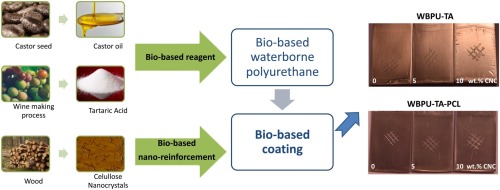当前位置:
X-MOL 学术
›
Prog. Org. Coat.
›
论文详情
Our official English website, www.x-mol.net, welcomes your feedback! (Note: you will need to create a separate account there.)
Bio-based waterborne polyurethanes reinforced with cellulose nanocrystals as coating films
Progress in Organic Coatings ( IF 6.6 ) Pub Date : 2020-07-01 , DOI: 10.1016/j.porgcoat.2020.105649 M. Eugenia V. Hormaiztegui , Bernardo Daga , Mirta I. Aranguren , Verónica Mucci
Progress in Organic Coatings ( IF 6.6 ) Pub Date : 2020-07-01 , DOI: 10.1016/j.porgcoat.2020.105649 M. Eugenia V. Hormaiztegui , Bernardo Daga , Mirta I. Aranguren , Verónica Mucci

|
Abstract In this study, two different bio-based waterborne polyurethanes (WBPUs) that use castor oil and tartaric acid in their formulations were modified by the incorporation of a renewable reinforcement, cellulose nanocrystals (CNC), to be further applied as metal coatings of tailored properties. Different mixed suspensions were prepared by blending aqueous suspensions of CNC with the WBPU dispersions to achieve CNC concentrations of 5 wt. % and 10 wt. % (dry basis). The viscosities of the mixed suspensions were adjusted, so that they could be used in dip-coating of aluminum plates, used as substrates. The coatings were tested using macroscopic methods such as knife and tape tests and contact angle. Microscopic techniques such as nanoindentation, nanoscratch and nanowear were carried out. The results showed the feasibility of using these nanocomposite WBPUs as coatings and the utility of the microscopic techniques in the characterization of the resulting surfaces.
中文翻译:

以纤维素纳米晶体作为涂膜增强的生物基水性聚氨酯
摘要 在本研究中,在配方中使用蓖麻油和酒石酸的两种不同的生物基水性聚氨酯 (WBPU) 通过掺入可再生增强材料纤维素纳米晶体 (CNC) 进行改性,以进一步用作定制的金属涂层。特性。通过将 CNC 的水性悬浮液与 WBPU 分散体混合以达到 5 wt% 的 CNC 浓度来制备不同的混合悬浮液。% 和 10 wt. %(干基)。调整混合悬浮液的粘度,使其可用于铝板的浸涂,用作基材。使用宏观方法测试涂层,例如刀和胶带测试以及接触角。进行了显微技术,例如纳米压痕、纳米划痕和纳米磨损。
更新日期:2020-07-01
中文翻译:

以纤维素纳米晶体作为涂膜增强的生物基水性聚氨酯
摘要 在本研究中,在配方中使用蓖麻油和酒石酸的两种不同的生物基水性聚氨酯 (WBPU) 通过掺入可再生增强材料纤维素纳米晶体 (CNC) 进行改性,以进一步用作定制的金属涂层。特性。通过将 CNC 的水性悬浮液与 WBPU 分散体混合以达到 5 wt% 的 CNC 浓度来制备不同的混合悬浮液。% 和 10 wt. %(干基)。调整混合悬浮液的粘度,使其可用于铝板的浸涂,用作基材。使用宏观方法测试涂层,例如刀和胶带测试以及接触角。进行了显微技术,例如纳米压痕、纳米划痕和纳米磨损。



























 京公网安备 11010802027423号
京公网安备 11010802027423号